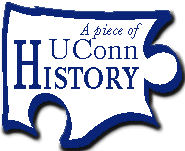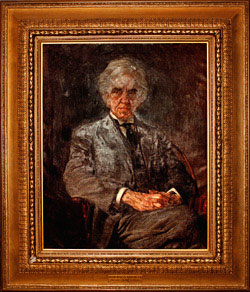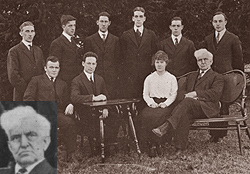This is an archived article. For the latest news, go to the Advance Homepage.
For more archives, go to the Advance Archive/Search Page 
| ||||||
|
Portrait of Henry Monteith depicts
"a gentleman and a scholar" November 30, 1998 On Tuesday, March 21, 1922, Henry R. Monteith arrived at the Dining Hall after his regular 11 a.m. Senior History class. He walked into the building — now the William Benton Museum — and took his usual seat in the faculty dining room.
As he began his meal, he mentioned to a waiter that he was feeling faint. The waiter brought a glass of water, and the venerable Monteith continued dining with a few faculty friends. Minutes later he saw John L. Hughes, assistant professor of chemistry, seated in another part of the room and moved to join Hughes at his table. The conversation was probably friendly, and certainly there must have been talk of the "Monteith Concert" scheduled for the next Thursday. The concert, an evening of readings and vocal and instrumental music, had been arranged by Monteith's daughter, a teacher at the Hartford Conservatory of Music. Originally scheduled for March 9 and postponed due to the illness of one of the performers, it would be held March 23 at 8:30 p.m. in Hawley Armory, featuring instrumental and vocal selections, solos and readings, and would be a fund raiser to help pay for a portrait of Monteith. For months, the Connecticut Campus reported progress on the portrait, for which Monteith had begun sitting in December 1921. The cost, originally put at $800, was negotiated to $600 with Hartford artist Harold Green, whose work, the Campus reported, was supervised by Robert Brandegee, "the famous artist." {Brandegee was one of the founders of the Connecticut Academy of Fine Arts.]
Prof. Montheith, wrote a Campus reporter, will be occupied "from now until Commencement with something we hope he will like to do. We think he will be pleased and no doubt the artist will also enjoy the work, for it isn't everyday that painters are given such interesting subjects to work upon, nor, on the other hand, are professors given many opportunities to have their portraits painted." When he retired in 1919, after nearly 20 years on the faculty of Connecticut Agricultural College, Monteith was named emeritus professor of history - the first faculty member of the college to receive the emeritus distinction. He had joined the CAC faculty in 1900 as a professor of political economy, history, civics and English. Reflecting the changing faculty, his duties changed frequently: in 1903 he is listed as a professor of history, civics, Latin and mathematics; in 1906, Latin was dropped from the curriculum; in 1914, his title was professor of history and French; in 1916, his subjects were English and French. Born in 1848 in McIndoe's Falls, Vt., Monteith studied law at Dartmouth, graduating in 1869 "as one of the youngest and brightest men in his class." He passed the bar in New York City and practiced law there for a few years before moving his practice to his hometown in Vermont. He began teaching in the town schools, and in the 1870s moved to Farmington, Conn., to teach in the Unionville school. From 1879 to 1899, he was principal of Farmington High School. "From the beginning of his work at Connecticut (Agricultural College), Professor Monteith manifested his deep interest in the problems and joys of the student body," said the Connecticut Campus. In the college's annual report for 1900, President George Flint said Monteith's "experience in the class-room and his ripe scholarship are already producing the best results." Flint knew Monteith well - he was his brother-in-law. For the same annual report, Monteith submitted a report for the Department of English, History, Civics and Political Economy (not to be confused with the then-separate Department of Rhetoric, English Literature, Elocution and Ethics). For a new faculty member, he pulled no punches. "It is a generally recognized fact that the common schools of the State provide in English Grammar a preparation that leaves much to be desired; the deficiency in the preparation in the necessary branch is noted even in our Colleges; and in an institution like this, whose students have none of the advantages of classical study in their preliminary work, the absence of thorough training in English is of itself almost a complete bar to anything like a successful prosecution of the scientific study so generously provided here," Monteith wrote. He also reported that he found CAC freshmen and sophomores studying the same English lessons from the same textbook "a spectacle," he wrote, "that it is hoped will never be repeated." Monteith arrived on campus in the middle of a raging faculty-administration battle that began in 1898 when trustees replaced Benjamin Koons with George Flint as president. The removal of Koons, who stayed on as a professor of natural science, was unpopular with most members of the faculty. Flint was in office a short time "when he came in collision with certain members of the faculty," wrote Walter Stemmons in his history of the University's first 50 years. "Opposition throughout the State began to increase as it became apparent from recurring reports from Storrs that President Flint was more interested in classical education than in agriculture," said Stemmons.
There were faculty and staff resignations, and Monteith was one of the replacements hired in what became known as the "War of the Rebellion." It ended with trustees demanding Flint's resignation in October 1901. Monteith's influence throughout his two decades in Storrs (he maintained residence in Farmington but stayed in Storrs at least three days a week), was felt strongly by students - he served on many faculty committees, including the Committee on Discipline, and most notably the Committee on Student Publications. As faculty adviser, he worked closely with students on the monthly student newspaper, The Lookout, and later the weekly Connecticut Campus. "It had become an almost unwritten law that no Aggie man's education was finished until he had taken a course under Professor Monteith," said a Connecticut Campus writer. The student paper closely followed the painting of the Monteith portrait, reporting on when sittings began, the course of the fund raising, and preparations for the concert. Now, three days before the concert, Monteith was with his friend and colleague John Hughes at the luncheon table. After a few moments, Hughes "noticed that Mr. Monteith stiffened in his chair while his head suddenly fell back and he seemed in faint. Professor Hughes immediately rose and tried to restore Mr. Monteith to consciousness by bathing his face in water but he did not recover," wrote the Connecticut Campus in its weekly edition on March 23, the day set for the Monteith Concert. Nurses from the campus infirmary were summoned, but it was too late. Monteith had died from what was determined to be a cerebral hemorrhage. The concert was canceled; proceeds from advance ticket sales were contributed to the portrait fund. The 1922 CAC annual report included a memorial to Montheith:
After a May showing at a New York City gallery, the Monteith portrait was unveiled in Storrs Friday, June 9, the day before Commencement. The portrait, exhibited in the Dining Hall for many years, is now in storage in the William Benton Museum of Art. The first edition of the Nutmeg Yearbook in 1915 was dedicated to Monteith, stating that "His classes are all proud of the 'Grand Old Man' of Connecticut, and honor and revere him as the highest type of that which we all aspire to be - 'a gentleman and a scholar." The 1922 Nutmeg carried a similar dedication, not to the man but to his memory. But a clearer picture of the man and his influence on CAC students comes from a short piece in the December 22, 1921, Campus about the forthcoming portrait. The piece includes an imaginary dialogue taking place in some future time in front of the completed painting, in "a magnificent library and auditorium at Connecticut. In the center hall will hang the portrait of a fine old man." The writer then eavesdrops as a visitor views the painting. "'Henry Ruthven Monteith - he must have been quite a man. 'A great man, sir! 'Ah, you know him, then? He was brilliant? 'He was a great scholar and very wise. 'A professor wasn't he? 'A professor? Yes, certainly, sir. A professor. But he was more than a professor, he was "Monty".'" Mark J. Roy Sources: The Connecticut Campus, various issues, Vol. VII and Vol. IX, 1922-1923; Connecticut Agricultural College: A History, Walter Stemmons, 1931. These and other materials on UConn's history are in the archives of the Thomas J. Dodd Research Center. |



